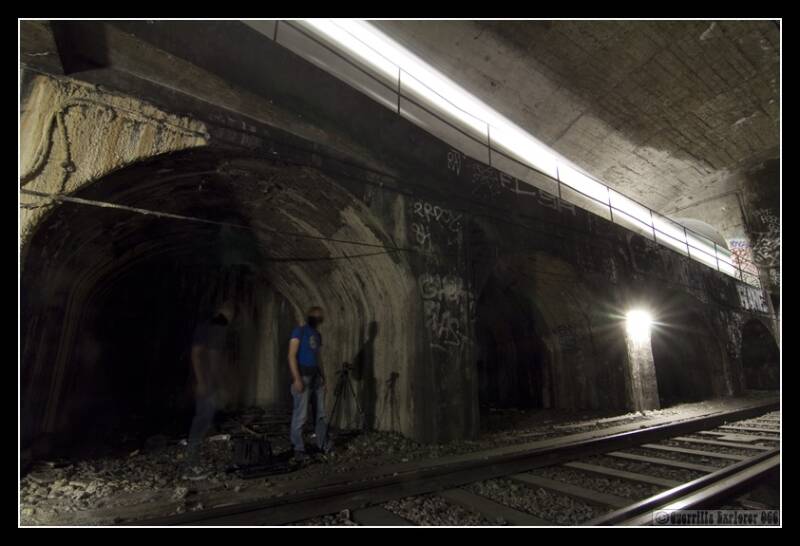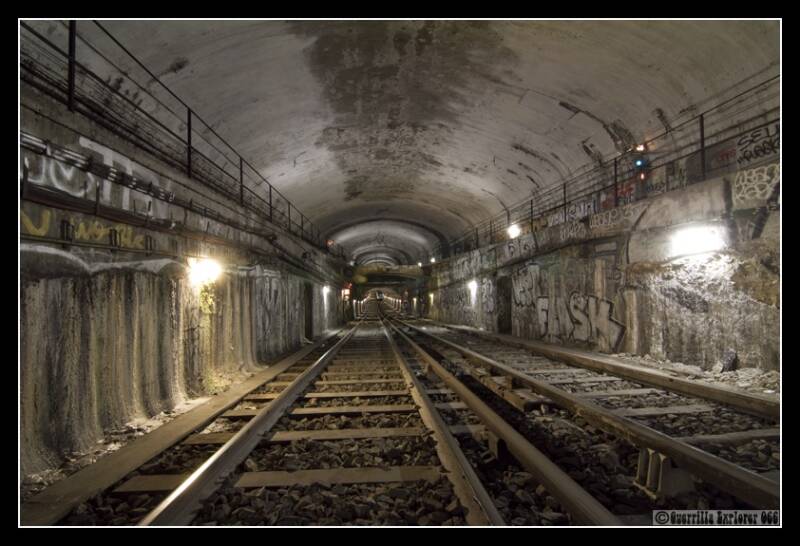GES120 Paris Raccords
Some fellow South East explorers had been to Paris and made in-roads into the Metro system, and from what I saw, the stations offered nothing special to me. All tagged to death and bereft of features. The only station picture to make me want some is by an Aussie explorer residing in Paris, at Croix Rouge Station. Sadly we didn't have time to get to it, only pass by.
No, when it comes to Paris Metro, the thing I liked most was the tunnels themselves along with the tracks. The way they follow their path over contours and round obstructions. When one stands in a city and looks in any direction, the buildings hide said contours. When sitting on a subterranean transit train, one doesn't really appreciate the contours being traversed. It's only when you're in a tunnel with the lights on, that you appreciate the feats of engineering that resulted in said contour traversing. When wanting to explore the Metro during daylight, it's best to avoid the main tunnels, due to the steel and aluminium beasts that soar through at reasonably regular intervals. No, if you want to explore during the day, then the Raccord tunnels are for you. Raccord means side or linking tunnel, as they allow trains to move between lines. As we'll see, they are also used for laying up trains out of service.
This wasn't my trip, so I wasn't paying much attention, merely following Patch's whim. We arrived at I think Opera Station, and with some magic, disappeared through a door in the station and were literally straight into the tunnel below. One end of which was a dead end.

The other side leads down a racc0rd tunnel (on the right below), and the other side leads to the live tracks. The rusted live rail sits furthest on the right-hand side of the pic, with protector boards beside the wooden plank footpath.

A live train pulling into the station nearby, one had to work out the timer and then run out of the way to avoid being seen by the driver. As the train was heading straight for the camera in this picture, before veering off to the left.

The empty raccord tunnel, and eery silence down here. I was, probably like the others, wary of a train suddenly hurtling down here. However, none ever came. Our only hope of avoiding being discovered was the alcoves, as seen on the left wall before the first light bulb.

Walking through the Raccord tunnel, it's only a few hundred metres long. The white light at the top is where the next station approach is. Trains go above where we are, the flat section of the roof ahead is in a section where you can see them going above.

An open section of the Raccord tunnel, as referred to above. Trains in service run down the tracks above on the left and right. As trains passed, we ducked into the large alcoves on the left and right.

A train passes over the top of Patch and Andy UselessPsychic. It's odd to describe the emotions and feelings that stood in a place like this. There is the sense of the forbidden, which is one of the reasons for being here. The rush and thrill of being where you shouldn't. However, for me, the main factor was seeing the innards of the system close up. To the average passenger, their train just arrives from a dark tunnel, they get on, ride through a dark tunnel, and arrive at their destination. It's what's in between that fascinates me. Also, where do other tunnels lead off and what other elements exist in the system? It's nerdy of course, but as an explorer, these sorts of things turn us on. Whether it's where a river leads in a jungle, or where a side passage leads in a sewer or metro system.

There was little point going to the next station as we'd be seen, so we went back to where we started. As a first taste of the Parisian Metro it was a splendid one. That night we foregoed the Hilton or Sheraton, and instead decided to sleep on the top floor of a building site near Park Monceau. This was a lift shaft with a wooden floor. I didn't have a sleeping bag with me, so didn't last long here with a light wind blowing over. So disappeared around the corner and slept under a makeshift tarpaulin tent.

A shot down a tunnel from the back of a cab. Similar to the view one faces when planning to run into a tunnel. You can see a thin path up against the wall on the left. The live rail sits in the middle of the tracks, so is one less problem to deal with.

To get to a famous set of 'tourist' tunnels, one had to run onto the tracks from the platform and cross two sets of tracks. This included crossing two live rails, while also checking if we'd been seen, and checking for trains. So intense amounts of concentration were needed. We kept going down the tracks into the raccord. The tracks we'd just crossed pass by above us, as we descend the slope.

According to Patch, this was a stroke of good fortitude. Finding a train laid up in a raccord. Trains are a prime target for taggers, and they're usually well-guarded with alarms and whatnot.

This type of train had easily openable doors, just a twist of the handle and we were in. It was then a chance to get some cab photos. Luckily Patch didn't have any ideas about trying to get the train moving!

The view from the cab, Patch and UselessPsychic working on their photos.

The carriages lay silent in the partial darkness, lit only by the tunnel lights outside.

After walking alongside the train, ever wary of a driver stepping out. It was actually two trains parked closely together.

The raccord returned to the service in the distance and the next station. Patch had spotted a camera up ahead, so there seemed little point continuing up the raccord.

Instead, we went to investigate a side door I'd noticed earlier. It leads into a mostly empty room with a subtle hint of fuel about it. A ladder lead up to the next level which was fairly similar. From that, a series of ladders and gantries lead up to the surface. Patch and I went up to investigate, and after several attempts, couldn't get the 'emergency exit' lid up. It consisted of two lids, and one seemed to push up the other. However apart from a brief lifting of a few centimetres, we couldn't repeat the event. We gave up and popped back out the heavy door into the raccord tunnel.

As we walked back up the tunnel, we had another problem to contemplate, judging the gap between trains. Sat out of site in the passage, another train shoots by at the top.

We got closer to the top of the raccord tunnel, our backs to the wall with the train passing by so it couldn't see us. As we did this, we could hear another train approaching the other tracks. It was a nightmare. After sitting and watching for 10 mins or so, running between sides to hide from the trains going by above. We decided to run behind the next train that went into the station and hop onto the platform as soon as it had begun to pull out. A train came by, and we ran like crazy monkeys with arms flowing in every direction as we were racing to get to the platform before the train left, but also making sure to not trip over near or touch the live rails.

We made it, just, and quickly disappeared into the station. It was an interesting collection of experiences, and we were bugged-eyed and spaced out on adrenaline for quite a while afterwards. We went to find the lid we'd been trying to get out of, but it wouldn't open from above either. We gave up, and Patch announced he wanted to search for a McDonalds.
During the trip, we did actually encounter a train driver. He thought explorers were really cool, and should be allowed to explore the system unhindered. He also agreed to a short interview if his identity was hidden
An interview with a 'genuine' Metro train driver on the trip - Link Here
Thanks to Patch and Andy.
Create Your Own Website With Webador